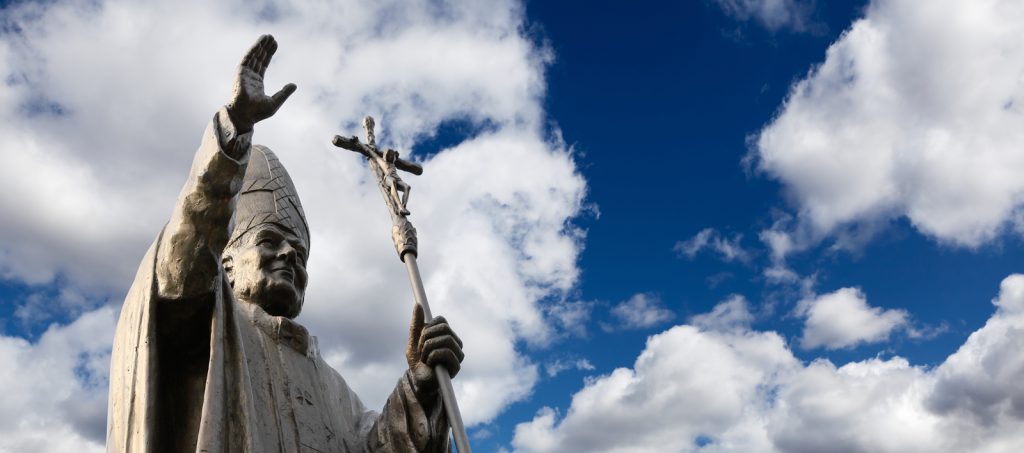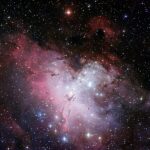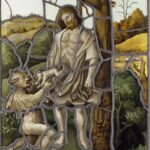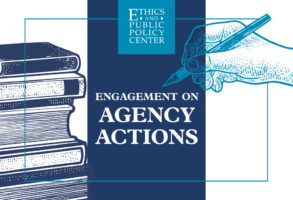
Published May 19, 2014
Bishop Farrell; Bishop Olson; President Keefe; members of the Board of Trustees; distinguished faculty members and university staff; parents and grandparents, brothers and sisters, aunts, uncles, and cousins of the graduates; and, most especially, my fellow members of the Class of 2014 of the University of Dallas:
Thank you for the invitation to share this day with you.
Three weeks ago, the Church recognized the heroic virtues of the two “bookend” popes of the Second Vatican Council, John XXIII and John Paul II, as Pope Francis solemnly declared them to be saints before a million pilgrims in and around St. Peter’s Square. St. John XXIII is the first bookend of Vatican II: the pope who had the inspiration to summon the 21st general council in the history of the Church, and the courage and wisdom to see the Council through its difficult first period in 1962. St. John Paul II is the second bookend of Vatican II because it was he, working in close harness with the man who would become his papal successor, Joseph Ratzinger, who gave Vatican II an authoritative interpretation through his remarkable magisterium.
Our two new saints are not random or accidental bookends, however. They’re a matched set of bookends, because both popes shared a vision of the Council’s purpose and a hope for the Council’s impact.
John XXIII wanted Vatican II to be a new experience of Pentecost for the world Church — a new encounter with the fire of the Holy Spirit that would enliven Christian witness at the end of the 20th century, offering the world the medicine of the divine mercy through which we experience the Truth who is the Triune God. John Paul II, on the day after his election as pope, said that the “full implementation” of Vatican II would be the program of his pontificate, a pledge he fulfilled over more than a quarter of a century. And in doing so, John Paul II led the Church into that new experience of Pentecost for which John XXIII hoped and prayed, through the Great Jubilee of 2000.
In closing the Great Jubilee on January 6, 2001, with the apostolic letter Novo Millennio Ineunte (which, for any non-UD graduates present, I will translate as “Entering the New Millennium”), John Paul II urged the Church of the 21st century and the new millennium to leave the comfortable but shallow waters of institutional-maintenance Catholicism and to “put out into the deep” of late modernity — to rediscover the evangelical and missionary passion that seized the first Christian community and led them into mission, once the Holy Spirit had given them the words with which to explain what they had “seen and heard” in their encounters with the Risen Lord.
The graduates of the University of Dallas are singularly well prepared to be the agents of this “New Evangelization,” as John Paul II called the grand strategy of the 21st-century Church that John XXIII had the courage to envision. For in the challenging cultural circumstances in which 21st-century Christians must witness to the Gospel and offer men and women the possibility of friendship with Jesus Christ, there is no better preparation for what Pope Francis has called “permanent mission” than the classic Catholic liberal-arts education for which the University of Dallas is known and respected throughout the world.
Here, through that classic Catholic liberal-arts education, you have learned the ecumenism of time, drinking deeply from those wells of wisdom that are fed by streams of knowledge and insight drawn from the great minds and spirits of the past.
Here you have learned that “tradition” is neither a synonym for dullness nor the enemy of human progress; for here you have learned that “tradition,” as the great Chesterton noted, is “the democracy of the dead,” the willingness to think that those who came before us — Homer and Virgil, Augustine and Aquinas, Dante and Milton and Shakespeare — may have important things to teach us.
Here, you have learned that the tradition of the West is built on the three pillars of Jerusalem, Athens, and Rome: biblical religion, which teaches us that life is a pilgrimage in which we are called to follow the God of Israel and the Church on the path He is taking through history; the Greek faith in reason’s ability to get at the truth of things that is embedded in the world and in us; the Roman conviction that the rule of law is superior to the rule of brute force.
Each of those pillars is under assault throughout the western world today. In the 19th century, what Henri de Lubac called “atheistic humanism” jettisoned the God of the Bible and declared that western high culture would henceforth be a God-free zone. In the 20th century, the deconstruction of the humanities in an aggressively secular academy led, not to liberated minds, but to minds chained in the prisons of uncertainty, skepticism, irony, and cynicism; in the 21st century, and as a result of what happened in the 19th and 20th centuries, the “dictatorship of relativism” prophetically analyzed by Benedict XVI now threatens the rule of law from Anchorage to Kiev and at all points in between.
So you, the class of 2014, have your work cut out for you: and that work is nothing less than the exhilarating, challenging, and sometimes dangerous task of giving the West a new birth of freedom rightly understood — freedom tethered to moral truth and ordered to goodness; freedom lived nobly rather than selfishly; freedom lived for the common good in solidarity with other pilgrims through history.
And if, in the years and decades ahead, that task of cultural renewal seems daunting, perhaps even impossible, remember that St. John Paul II believed that you could do it — that your generation could lead the world into what he called, at the United Nations in 1995, a “new springtime of the human spirit.”
John Paul II’s confidence in young people was a happy by-product of his early years in the priesthood — when he was a university chaplain in Cracow in the late 1940s and early 1950s, in a country choking on the acrid fumes of Stalinism after being beaten for over five years by the lethal scourges of German National Socialism. With the young men and women he met at the Cracow Polytechnic, the Cracow Academy of Music, the Cracow Academy of Fine Arts, and other institutions of higher learning in that beautiful city, young Father Karol Wojtyła formed remarkable networks of friendship and solidarity that lasted for more than half a century. The lay friends Father Wojtyła made in those years remained among his closest friends until his death in 2005. And as he helped form his young friends into mature Christian men and women, preparing them for the vocation of marriage or helping them discern vocations to the priesthood or religious life, they helped form him into one of the most dynamic priests, and later one of the most dynamic bishops, of the Church.
In those networks of friendship, Wojtyła came to understand something that the Second Vatican Council would later put at the center of its reflection on the Church: what the Council called, 20 years or so after Wojtyła and his young friends lived it, the “universal call to holiness.” The Church, Wojtyła and his young friends came to understand, exists for holiness — for enlivening and empowering what the grace of God makes possible in all of our lives. Sanctity is not a matter for the sanctuary alone; sanctity is every Christian’s human and baptismal destiny.
The networks of friendship Father Karol Wojtyła created with young people — young people very much like you — were zones of freedom and zones of truth in a world of tyranny and lies. Here, Wojtyła’s young friends met the great minds and spirits of western civilization: just as you have done at the University of Dallas. Here, in these zones of truth and freedom, Wojtyła’s young friends learned compassion and charity and the dignity of every human life, at all stages of life and in all conditions of life: just as you have done at the University of Dallas. Here, in the free space for free conversation created by the openness of Father Karol Wojtyła, the man who would become pope, Wojtyła’s young friends learned to live their lives, not simply as a matter of “career,” but as a matter of vocation, discerning that unique something that God has in mind for every human life: just as you have begun to do at the University of Dallas.
In this remarkable story of friendship, we can see the beginnings of some of great things for which the pontificate of John Paul II would become noted: World Youth Days; the Theology of the Body; the call to the laity to convert the world; the dialogues between science and religion, and between the humanities and religion; even the Great Jubilee of 2000. And in exploring those early years in the priestly life of St. John Paul II, I think we find answers to a question I have been asked dozens of times: Why was John Paul II such a magnet for the young?
The answer to that question can’t be celebrity goofiness, of the sort to which we’re all unhappily accustomed in this cultural moment; celebrities never did what John Paul II did with young people, and in any event, in the last, difficult years of his life, the bent and crippled John Paul II didn’t look like any “celebrity.” Yet the magnetism remained, and in the days before he died, thousands of young people from all over the world came to St. Peter’s Square to keep vigil outside the pope’s window, to help him in his dying as he had helped them in their living.
Why?
I think there are two reasons why John Paul II was a magnet for the young.
The first was his transparent honesty. There was no falseness in the man, no hedging, none of the ambiguity that is often a postmodern mask hiding deep confusion. He did not ask young people to do anything he had not done. He did not ask young people to bear any burden he had not borne. He simply asked them to let him, and the Church, accompany them on the pathways of life, in moments of failure as well as moments of success, so that those pathways might eventually become a pilgrim’s progress toward sanctity.
And the second reason why John Paul II was a magnet for the young was his challenge. Unlike 21st-century popular culture, John Paul II did not pander to young people. He challenged young people, because he knew, from his experiences with his young friends in Cracow, that young people want to be summoned to live lives of heroism — that young adulthood is a time to dream great dreams, to imagine how things ought to be, and to bend heroic efforts to fixing what is broken in our own lives and in society.
Above all, John Paul II’s challenge to young people was a challenge to claim, and own, and live their human dignity. In a host of variations on one great theme, John Paul II said the same thing to millions of young people in Rome, Buenos Aires, Compostela, Częstochowa, Denver, Paris, and Toronto: Never, ever settle for anything less than the spiritual and moral grandeur that the grace of God makes possible in your lives. Never settle for less than that. You will fail, as we all do; but that is no reason to lower the bar of expectation. Get up, dust yourself off, seek forgiveness and reconciliation, and try again. But never, ever settle for anything less than the spiritual and moral greatness that is available to you, and of which you are capable by God’s grace. Don’t ever settle for less than that.
If the generation of which this Class of 2014 is a part is going to meet the challenge of giving America, and the West, a new birth of freedom, it will do so because it becomes a generation of saints: well-educated, thoughtful, and articulate saints; compassionate and merciful saints; saints for the new millennium who refuse to surrender to the tyranny of low expectations, personal and public; saints in the image of the young Pole who never imagined himself pope, but whom the Church and the world now know as Pope St. John Paul II.
He is now more than an image to ponder, an example to emulate. He is your powerful intercessor. And St. John Paul II will not fail to support you as you go out, today, from this great university to the ends of the earth, contemporary witnesses to the ancient and enduring truths you have made your own here.
Godspeed on your journey.
George Weigel, the biographer of Pope St. John Paul II, is distinguished senior fellow of Washington’s Ethics and Public Policy Center, where he holds the William E. Simon Chair in Catholic Studies.







